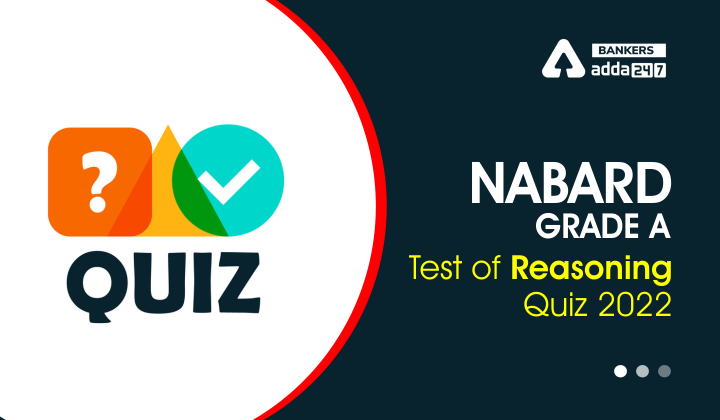Directions (1-5): In the following question, some statements are followed by some conclusions. Assuming the given statements to be true, find which of the two conclusions follow(s) the given statements and choose appropriate answer choice.
Q1. Statements: Z > S ≥ C = D, F < U > T ≥ H, P ≤ O < C > U
Conclusions:
I. Z > H
II. D < H
(a) Only I follow
(b) Only II follow
(c) Both I and II follows
(d) Either I or II follows
(e) Neither I nor II follows
Q2. Statements: S > W ≥ Z < R, T ≤ B > U = I, M < W > B ≥ V
Conclusions:
I. Z < T
II. S > I
(a) Only I follow
(b) Only II follow
(c) Both I and II follows
(d) Either I or II follows
(e) Neither I nor II follows
Q3. Statements: B < S ≤ D = F, L > I < J > H, P > F ≤ G = I
Conclusions:
I. B < J
II. G ≥ S
(a) Only I follow
(b) Only II follow
(c) Both I and II follows
(d) Either I or II follows
(e) Neither I nor II follows
Q4. Statements: G = A ≥ E > D, U ≤ J = R ≥ F, T < H > E ≥ J
Conclusions:
I. G > U
II. G = U
(a) Only I follow
(b) Only II follow
(c) Both I and II follows
(d) Either I or II follows
(e) Neither I nor II follows
Q5. Statements: B > D ≥ S < X, F < V ≤ N > C, J ≤ M < S =N
Conclusions:
I. D > V
II. D < V
(a) Only I follow
(b) Only II follow
(c) Both I and II follows
(d) Either I or II follows
(e) Neither I nor II follows
Directions (6-10): In the following questions assuming the given statement to be true, find which of the conclusion(s) among given conclusions is/are definitely true and then give your answers accordingly.
Q6. Statements: Q > A = E ≥ S = T, J = A > L ≥ M, Y = R ≥ A > O
Conclusions:
I. Y < Q
II. Y > M
(a) Only conclusion I is true
(b) Only conclusion II is true
(c) Either conclusion I or II is true
(d) Both conclusions I and II are true
(e) Neither conclusion I nor II is true
Q7. Statements: G < Q = C ≤ N = X, S > N = E > M, Z = J = S > L
Conclusions:
I. Z > G
II. L > C
(a) Only conclusion I is true
(b) Only conclusion II is true
(c) Either conclusion I or II is true
(d) Both conclusions I and II are true
(e) Neither conclusion I nor II is true
Q8. Statements: N ≤ T = H < M, N = W ≥ K > S, P ≤ M = D
Conclusions:
I. H > S
II. W < M
(a) Only conclusion I is true
(b) Only conclusion II is true
(c) Either conclusion I or II is true
(d) Both conclusions I and II are true
(e) Neither conclusion I nor II is true
Q9. Statements: V ≤ P = C ≤ H, N ≥ C < E = Y, P = L ≤ S = T
Conclusions:
I. L > Y
II. N ≥ V
(a) Only conclusion I is true
(b) Only conclusion II is true
(c) Either conclusion I or II is true
(d) Both conclusions I and II are true
(e) Neither conclusion I nor II is true
Q10. Statements: I = E > W < L, D ≤ F = E < X, X < T = G > A
Conclusions:
I. I < G
II. L < A
(a) Only conclusion I is true
(b) Only conclusion II is true
(c) Either conclusion I or II is true
(d) Both conclusions I and II are true
(e) Neither conclusion I nor II is true
Directions (11-13): In the following questions assuming the given statement to be true, find which of the conclusion(s) among given conclusions is/are definitely true and then give your answers accordingly.
Q11. Statements: G > I ≥ C, C = D > E, G ≥ F
Conclusions:
I. G > C
II.F > I
(a) Only I is true
(b) Only II is true
(c) Either I or II is true
(d) Neither I nor II is true
(e) Both I and II are true
Q12. Statements: G > I ≥ C, C = D > E, G ≥ F
Conclusions:
I. G > D
II.G = D
(a) Only I is true
(b) Only II is true
(c) Either I or II is true
(d) Neither I nor II is true
(e) Both I and II are true
Q13. Statements: G > I ≥ C, C = D > E, G ≥ F
Conclusions:
I. F > C
II. F ≤ C
(a) Only I is true
(b) Only II is true
(c) Either I or II is true
(d) Neither I nor II is true
(e) Both I and II are true
Directions (14-15): In the following questions, a statement(s) are given followed by some conclusions. Study the following data carefully and answer the questions accordingly.
Q14. Statements: U = X ≥ I, C ≤ D > I = L ≥ G > H
Conclusions:
I. G ≤ I
II. L < U
(a) If only conclusion I follows
(b) If only conclusion II follows
(c) If either conclusion I or II follows
(d) If neither conclusion I nor II follows
(e) If both conclusions I and II follow
Q15. Statements: A > J = K ≥ Z = M ≤ O, J < R ≤ V
Conclusions:
I. Z < O
II. O = Z
(a) If only conclusion I follows
(b) If only conclusion II follows
(c) If either conclusion I or II follows
(d) If neither conclusion I nor II follows
(e) If both conclusions I and II follow
Solutions
S1. Ans. (a)
Sol. I. Z > H – True
II. D < H – False
S2. Ans. (b)
Sol. I. Z < T – False
II. S > I – True
S3. Ans. (c)
Sol. I. B < J -True
II. G ≥ S – True.
S4. Ans. (d)
Sol. I. G > U – False
II. G = U – False
S5. Ans. (e)
Sol. I. D > V – False
II. D < V – False
S6. Ans. (b)
Sol. I. Y < Q – False
II. Y > M – True
S7. Ans. (a)
Sol. I. Z > G – True.
II. L > C – False
S8. Ans. (d)
Sol. I. H > S – True.
II. W < M – True.
S9. Ans. (b)
Sol. I. L > Y – False
II. N ≥ V – True.
S10. Ans. (a)
Sol. I. I < G – True.
II. L < A – False
S11. Ans.(a)
Sol. I. G > C – True.
II.F > I – False
S12. Ans.(a)
Sol. I. G > D – True.
II.G = D – False
S13. Ans.(c)
Sol. I. F > C – False
II. F ≤ C – False
S14. Ans.(a)
Sol. I. G ≤ I – True.
II. L < U – False
S15. Ans.(c)
Sol. I. Z < O – False
II. O = Z – False





 GA Capsule for SBI Clerk Mains 2025, Dow...
GA Capsule for SBI Clerk Mains 2025, Dow...
 The Hindu Review October 2022: Download ...
The Hindu Review October 2022: Download ...
 IBPS RRB Clerk Cut off 2025, Check Previ...
IBPS RRB Clerk Cut off 2025, Check Previ...





